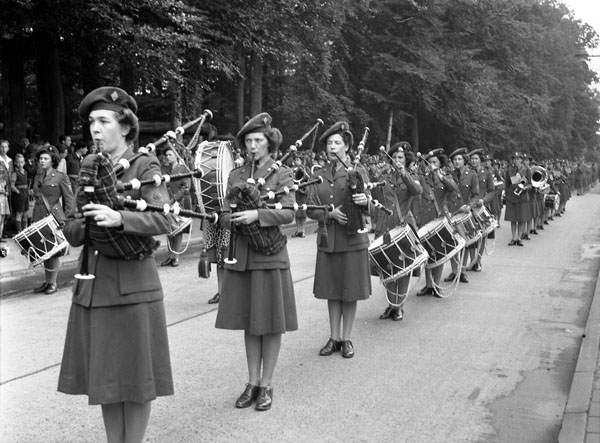Isabelle Garcia Phillips, Second World War veteran (born 11 March 1921 in New Westminster, BC; died 21 August 2000 in Surrey, BC). Garcia Phillips was one of thousands of Canadian women who volunteered for service during the Second World War. She worked briefly as a riveter for Boeing Aircraft of Canada during the war, before enlisting in the Canadian Women’s Army Corps (CWAC). She is one of the few women of Filipino heritage to serve in the CWAC. Her father, Peter Garcia, also served in the Canadian army, while her brother Don Garcia later became a prominent figure in the labour movement.

Early Life
Isabelle Garcia Phillips was born Sophia Isabelle Garcia on 11 March 1921 in New Westminster, British Columbia. She was a sixth-generation New Westminster resident whose roots could be traced to immigrant Filipino and Pacific Islander families and the local Squamish peoples (see Central Coast Salish). Both her father, Peter Garcia, and mother, Sadie Elizabeth Garcia (née Clarke), were born in British Columbia. In 1920, the couple married in Washington state where Peter’s relatives were based. Sophia Isabelle, their first daughter, was named after Sadie’s mother, Sophie Browne, but was known as Isabelle or “Issie”. The couple went on to have another five daughters and three sons, including trade unionist Don Garcia. Isabelle Garcia grew up with her mother’s extended family in the Brownsville area in Surrey. After finishing her elementary education, she went to high school in South Westminster, completing grade nine.
Second World War
Before the Second World War, Isabelle Garcia worked seasonal jobs in fish packing, canning fruit and pickling vegetables. However, a new opportunity opened for local residents in 1939, after Boeing Aircraft of Canada built a manufacturing plant on Sea Island, located in the middle of the Fraser River Delta, in Richmond, British Columbia. There, hundreds of employees made the airplanes needed for Canada’s increasing involvement in the war.
Many of the employees were women who were recruited to perform jobs previously reserved for men. (See Canadian Women and War.) Garcia, who stood 5 feet 1 inch tall and weighed 104 lbs, was hired as a riveter at the Boeing plant. Like the popular wartime icon Rosie the Riveter, she and her colleagues picked up the slack as men were drafted to train and fight overseas. (See also Veronica Foster, Canada’s “Ronnie the Bren Gun Girl.”) It was a physically demanding job, however, and Garcia found the noise “too much,” leaving after six months of employment.
In July 1944, Garcia interviewed for a position with the Canadian Women’s Army Corps (CWAC), where she hoped to become a driver. Given her petite build, however, she was rejected for that occupation. Disappointed, she spent the next few months at home or visiting family and worked briefly at the fish packing plant. In early 1945, she decided to enlist in the CWAC, taking whatever trade or occupation that was offered. Her father, Peter Garcia, also served in the army during the war in the Royal Canadian Army Service Corps.

On 28 February 1945, she was accepted as a private and received her regimental number W-111595. In April, Private Isabelle Garcia completed a four-week basic training course at the CWAC Basic Training Centre in Kitchener, Ontario, followed by specialized training as a clerk in Toronto in May and June. In July, she was transferred to Vancouver. After the atomic bombings of Hiroshima and Nagasaki in August, however, the war quickly ended. Garcia worked as a clerk and mail runner in the CWAC until she was officially discharged from service on 14 May 1946. She received the Medal 1939-1945 and the General Services Corps Badge No. 886, 840.
The three women’s services were disbanded in 1946: the CWAC in September, the Women’s Royal Canadian Naval Service in August and the Royal Canadian Air Force Women’s Division in December. It was not until May 1951 during the Korean War that women were enlisted again in the armed forces. (See Women in the Canadian Armed Forces.)
After the War
Isabelle Garcia, however, would not re-enlist in the armed forces. Upon discharge from the CWAC, her stated intention was to marry; she didn’t foresee employment outside the home, never mind in the army. She soon married William Phillips and devoted herself to managing their family home in Bridgeview, Surrey, and raising their daughter. She passed away on 21 August 2000 aged 79 in Surrey. Her remains were cremated and placed in a niche in Surrey’s Valley View Memorial Gardens where her husband was also laid to rest.
Did you know?
In April 1926, Garcia received a $100 Victory bond from the draw made by the war veterans at Shaughnessy Military Hospital in Vancouver. Victory bonds were loans made to the government by Canadian citizens to finance military operations and other costs in times of war.

 Share on Facebook
Share on Facebook Share on X
Share on X Share by Email
Share by Email Share on Google Classroom
Share on Google Classroom



